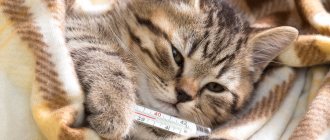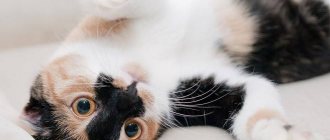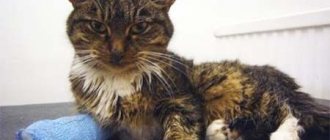Danil Ignatievich Safronov
veterinarian Petstory
Calcivirosis in cats is a very common infectious disease, the causative agent of which is very contagious and can easily mutate. Most often, the virus affects the upper respiratory tract of cats, but pathogenic effects on other organ systems are also found. After contact with the pathogen, the incubation period (from infection to the appearance of the first symptoms) lasts, according to various sources, from 2 to 14 days.
Symptoms of calcivirosis in cats
Depending on the virulence (aggressiveness) of the virus, the infection can manifest itself in different ways. Symptoms of calcivirosis in cats depend on the form of the disease and can last from several days to several weeks.
Typical signs of the respiratory form include:
- ulcers in and around the mouth (on the tongue, gums, hard palate, lips, nose);
- hypersalivation or drooling (due to mouth ulcers);
- fever and, as a consequence, apathy;
- anorexia (refusal to eat);
- conjunctivitis, discharge from the eyes;
- gingivitis, stomatitis;
- sneezing, nasal discharge;
- shortness of breath, cough.
- A complicated course of the disease can lead to pneumonia, as well as joint damage, which manifests itself as lameness.
In recent years, a virulent systemic form of calcivirosis, characterized by a hyperacute course, has become increasingly common. It is associated with mutations of the virus and is characterized by damage to various internal organs, leading to severe multiple organ failure (hepatitis, pancreatitis, vasculitis, pneumonia, etc.). The mortality rate for this form is very high. Clinically manifests itself in the form of subcutaneous swelling, ulcers on the skin of the ears, paw pads, nose, and around the eyes.
With calcivirus infection, its chronic course is also noted, in which the above-described symptoms may periodically occur. Some cats can be carriers of feline calcivirus for a long time, without showing any signs of illness and retaining the ability to transmit the virus to other cats.
Mechanism of disease development
The causative agent of calicivirus enters the cat’s body and begins to actively multiply. As a result, smooth bubbles in the shape of hemispheres with clear boundaries form on the oral mucosa.
Their diameter is usually from 0.5 to 1 mm. The location of these bubbles is the upper and lateral parts of the tongue, the hard palate and the outer surface of the nostrils.
After a few days, the blisters burst, and ulcers form in their place. When carrying out therapeutic measures over the next 2-3 weeks, the mucous membranes at the sites of ulcers are restored.
Calicivirus multiplies most actively in cats in the submandibular lymph nodes and recesses of the tonsils. After treatment ends, the virus remains in the tonsils for several weeks. During this period, the animal is a carrier of the infection.
If left untreated, the ulcers deepen into the mucous membrane. In addition, the virus can penetrate the lungs and bronchi, causing their necrosis and the development of pneumonia. In especially severe cases, the causative agent of the disease affects the brain and leads to the death of the cat.
How does infection occur?
Owners of both domestic pets and animals with access to the street should be concerned about infection with calcivirus. Immediately after the virus enters the cat’s body, the mucous membranes of the mouth, nose, and conjunctiva are damaged. Once the virus multiplies there, it can spread through the bloodstream to other organs.
Calcivirosis in cats is a disease that is transmitted in several ways:
- Direct - direct contact with a sick animal and its secretions in which the virus is localized (saliva, discharge from the eyes, nose or skin lesions).
- Indirect - contact through cat household items (bedding, bowls, trays) and contaminated (contaminated) discharge of the patient. Cases of calcivirus infection through fleas and their feces have also been described.
According to various sources, the virus persists in the environment from a week to a month and is relatively resistant to most disinfectants.
The following categories of cats are most susceptible to infection:
- unvaccinated adult animals and kittens;
- cats kept crowded in large groups (in nurseries, shelters);
- elderly animals;
- animals with weakened immune systems (for example, cats with chronic viral infections, as well as those receiving immunosuppressive therapy).
Cats usually shed the virus within two or three weeks of infection, but some become lifelong carriers and continue to shed the virus for a long time.
Hurry up, choose a box and find out what gift awaits you
Discount on pet insurance
Promo code copied to clipboard
Treatment of calicivirus infection
First of all, treatment is aimed at eliminating the bacterial infection and preventing the occurrence of secondary infections that occur due to decreased immunity. Antibiotics are prescribed for this.
In the absence of appetite and elevated temperature, the doctor prescribes infusion therapy.
Special preparations are used for washing (local sanitation) of the oral cavity and eyes, and treating ulcerated surfaces of the mucous membranes.
To speed up recovery, you must follow a diet - food should be liquid, pleasant in taste and smell, and always high in calories.
It is necessary to promptly ventilate the room in which the animal is kept in order to avoid the accumulation of the virus.
It is important to know that most cats spread the virus in their saliva for another 30 days after recovery. And some cats can remain virus carriers for a long time, and be potentially dangerous to members of their species.
Diagnostics
First, anamnesis is collected and the animal is examined. It is important to note that the presence of characteristic clinical signs of calcivirosis does not guarantee an accurate diagnosis. Therefore, laboratory diagnostics are required.
Calcivirus in a cat is diagnosed by polymerase chain reaction (PCR diagnostics), which is the main laboratory method and allows you to detect even a small part of the genetic material specific to calcivirus. For this study, material is taken from the animals from the oropharynx, nasal mucosa, conjunctiva, and scrapings are made from lesions on the skin. The selected material is then sent to a laboratory to identify the virus.
Test results should be interpreted carefully. Recent vaccination with live vaccines may cause a false positive result. False negative results are more likely to occur if the cat is swabbed more than a week after the onset of infection. It follows that laboratory results must be evaluated together with clinical manifestations.
Depending on the examination, the veterinarian may recommend additional diagnostic tests: clinical blood test, biochemical analysis of blood serum. As part of instrumental diagnostics, a chest X-ray can be used to identify changes in the lung tissue characteristic of pneumonia.
How is calcivirosis diagnosed?
The symptoms of this disease do not make it possible to make a diagnosis without additional research. The thing is that they are similar to other diseases that affect cats. During the diagnostic process, the veterinarian should completely exclude other diseases:
- chlamydia;
- bordetellosis;
- herpes;
- viral rhinotracheitis;
- stomatitis;
- gingivitis;
- rabies.
First of all, the cat is given a general blood test. Many veterinarians consider it uninformative, but in case of calcivirosis it can become an additional diagnostic method. As a result of the analysis, with the development of a calcivirus infection, a decrease in the level of leukocytes will be reflected.
Additionally, the pet needs to undergo a serological test on paired sera (the level of antibodies to the virus is checked) and an x-ray of the lungs and limbs. Only after a full range of studies and examination of the cat by a professional can a diagnosis be made with confidence.
Treatment of calcivirosis in cats
We will tell you in more detail below how and how to treat calcivirosis in cats.
Calcivirosis is a disease that has no specific (antiviral) treatment. Basically, symptomatic and supportive therapy is provided. A common complication is secondary bacterial infections that require antibiotics.
Affected cats often have decreased appetite due to a poor sense of smell, and/or are unable to eat due to oral soreness. In this regard, it is recommended to use soft, wet food, slightly warmed (for flavor), which will attract the attention of a sick cat. However, if the anorexia is severe and the cat does not eat for more than a day, hospitalization may be required and feeding will be done through an esophageal tube. This is a very important point; the cat should not starve, as this will significantly worsen the disease and slow down recovery!
Depending on the condition, intravenous infusions to correct dehydration and electrolyte disturbances, painkillers and antipyretic (non-steroidal anti-inflammatory) drugs may be used. Discharge from the eyes and nose must be carefully removed. If nasal congestion is severe and breathing is difficult, inhalation of saline solution (nebulizer) may be necessary to facilitate the passage of mucous discharge. If necessary, mucolytic drugs are prescribed.
To treat oral ulcers, you can use saline solution or a cat oral hygiene product (such as Stomadin Gel). It is not recommended to use iodine-containing preparations.
Feline calcivirus is a serious disease, and the approach to treatment may vary in each case. Therefore, for any manifestations of the disease, it is better to immediately contact a veterinary clinic and not self-medicate at home.
Treatment at home
A virus is a very dangerous thing. If symptoms of the disease appear, it is important to immediately contact the clinic. A veterinarian can diagnose a cat with, for example, pneumonia, and in such cases, hospital treatment is indicated. There is no specific cure for calcivirosis, so treatment is usually symptomatic and often possible at home. It is usually practiced in cases where the form of the disease allows it.
In uncomplicated forms of calcivirosis, the cat can be treated at home
Saline solutions
A sick cat is placed in quarantine, for example, in a separate room. Next, he needs treatment and quality care. The veterinarian prescribes medications that must be used strictly as prescribed. Daily procedures are also necessary:
- cleaning the nose and wiping the eyes;
- mouth rinse;
- treatment (washing) of ulcers on the tongue, etc.
Eye drops
Tobrex, Maxidin or Tsiprovet drops are usually used for the eyes. They contain antibiotics, so they are used as directed by your veterinarian. For example, Tsiprovet is instilled 4 times a day for two weeks. Some owners stop treatment when the symptoms disappear, but this is wrong: conjunctivitis may return in a stronger form.
Sometimes the owners of a sick cat buy drops with hormones, like for people. This solution cannot be used for calcivirosis. Corticosteroids greatly reduce immunity, and with calcivirosis in cats it is already very weak.
Some people treat their cats with folk remedies. I heard that tea helps with conjunctivitis, although this is how I treated my child’s eyes. Previously, you had to brew tea, strain it through gauze, and then make lotions. Now everything is simpler: you can brew tea bags, squeeze them and apply them to your sore eyes. Although, of course, a folk remedy cannot be considered as effective as drops from a pharmacy. By the way, even the most proven folk remedy for the eyes should be used until the conjunctivitis completely goes away. To do this, you need to alternate it with special drops.
Photo gallery: eye drops
You can buy eye drops at any pet pharmacy.
Most eye drops are available without a veterinarian's prescription.
Eye drops must not contain corticosteroids
Nasal drops
Separately, you need to select nasal drops (although the same Maxidin is suitable for this). It is difficult to rinse a cat's nose; animals do not like to trust it to people. However, the cleanliness of the nose determines how freely the cat can breathe. Breathing through your mouth causes a dry throat, which increases discomfort. To treat the nose, first use cotton pads or napkins, carefully removing secretions so that it becomes possible to instill the solution directly into the nostrils.
Ordinary saline solution is perfect for nasal drops (sodium chloride solution can be easily bought even in a regular pharmacy, it is inexpensive). It can be administered using a syringe without a needle under slight pressure, the main thing is that the liquid passes into the nasal passages. Any spilled solution should be immediately wiped off with a clean cloth. This will clean your cat's nose. You can buy antibacterial drops separately - Isofra, Anandin or Thymogen). It is important to follow the dosage; overdoing it with such drugs is dangerous.
Aloe juice is used as a folk remedy. But it is very bitter, so it may be difficult to bury.
Photo gallery: folk and pharmacy remedies for rinsing the nose of cats
Using saline solution is convenient to rinse your cat’s nose, but you still need antibacterial drops
Anandin can be bought at a pet pharmacy
Aloe juice is an effective folk remedy for rhinitis
Galazolin can be used instead of Isofra
Oral care
Oral treatment is also required. To make the ulcers on the tongue heal, you can use antiseptic and wound healing agents (Iodinol, Dentavedin, Metrogyl Denta). Some people use Lugol to treat their mouth. Now you can buy it in the form of a spray, but cats don’t really like it. And also your pet will be dissatisfied with chlorhexidine.
As a folk remedy, you can use strong tea or chamomile decoction. If you don’t have prepared chamomile, you can buy it at a regular pharmacy for people, for example, in the form of bags. They are easy to brew, and the resulting solution will taste neutral. However, this is a weak remedy; it will have to be alternated with stronger solutions or gels.
I prescribe Lozeval 0.1-0.2 ml to be injected into the mouth - it will distribute itself there. This thing is very unpleasant, the cat will not like it, it will drool. It helps well, it is safe, it is also prescribed internally, so whatever is swallowed will be beneficial.
nastyk123, forum user, veterinarian
https://www.veterinar.ru/forum/viewtopic.php%3Fid%3D5707
Photo gallery: means for sanitation of the oral cavity
Iodinol does not taste very pleasant, but many veterinarians prescribe it for oral care in cats.
Dentavedin is a special remedy for the treatment of the oral cavity of cats and dogs.
Gels Metrogyl, Zubastic and others have a pleasant taste, so cats are lenient towards them
Chamomile officinalis - a folk remedy for treating the oral cavity
Special diet
A cat with calcivirus may die not because of the virus itself, but because of inflammation or hunger. Many pets infected with this disease cannot eat, while they rapidly lose weight, and as a result, the body becomes so weakened that it loses the ability to fight the virus. Due to inflamed nasal passages, the cat loses its sense of smell, and ultimately its appetite. Therefore, the owners have to force feed the cat.
You can grind the food in a blender until it becomes a paste, and then add water or broth to it. Such food should be poured into the mouth with a syringe without a needle. When I had to force-feed my cat, I unclenched her jaws and poured liquid food from the side (near her cheek), close to the root of her tongue. This is how the animal has to swallow food. It is better to pour in food in small portions to make it easier for the cat to swallow. If you squeeze out too much food, your cat may choke. She, of course, can clear her throat, but after eating this much she will also begin to be afraid of the syringe.
Veterinarians sometimes recommend buying wet food from an expensive series. It has a softer consistency and smells better. Remember: the more appetizing the food, the more likely it is to feed your cat. At the same time, food should be high in calories, even a small portion of food should have good nutritional value. You can also give vitamins along with food, but they will be prescribed by a veterinarian.
To feed a sick cat you need to use soft and high-calorie food
Pharmaceutical drugs prescribed by a veterinarian
Only a veterinarian can prescribe the correct treatment, and self-medication can harm your pet. Doctors usually prescribe complex treatment for calcivirosis:
- antibiotics (to reduce the likelihood of secondary infection due to decreased immunity);
- decongestants - to cleanse the nasal passages;
- anti-inflammatory drugs (except for medications for the eyes, nose and mouth, medications for joints and fever may be prescribed);
- sometimes hyperimmune serums and globulins are prescribed (for example, Vitafel);
- veterinary painkillers (Butorphanol, Nalbuphine, etc.);
- immunomodulators, antiviral drugs and immunostimulants (for example, Fosprenil or Immunofan).
The cat owner needs to be especially careful with medications for people. Some owners of sick animals are trying to replace prescribed drugs with cheaper, human ones. Painkillers are sometimes replaced by economical cat breeders with analgin or aspirin. Often cats die from such treatment, because the animal’s body is structured completely differently. Nurofen, for example, can severely disrupt kidney function, and No-shpa can cause paresis or paralysis. Sedatives and hormonal medications are also not recommended for cats. The only exceptions are levomecithin drops or Tobrex (and then only as a temporary measure).
Additionally, your veterinarian may prescribe Ringer's solution, saline, or glucose by injection or IV. Such prescriptions are usually made in case of dehydration. If the animal owner does not have medical or veterinary skills, then it is better to entrust intravenous infusions to professionals. I gave my cat subcutaneous and intramuscular injections, but I’m afraid to give IVs (although I have a medical education, I’ve given IVs to people more than once).
Only a veterinarian can prescribe the correct (safe and effective) medications for your cat.
What to do if your kitten is sick
Small kittens are much more susceptible to calcivirus than adult cats. Symptoms in children are more pronounced, and treatment is more difficult. A kitten's illness usually begins with a high fever (temperature rises to 40 degrees). In this case, there is copious discharge from the eyes, nose and mouth. Because of this, the chest and face of the animal are constantly wet. Sores (in the form of bubbles with liquid inside) may appear on the palate, tongue, nose and lips, then they burst and ulcers appear. The fever will go away in 3-4 days, but other symptoms will remain for some time.
In addition to all the problems listed above, there is one more - the kitten’s immunity. The body of an adult cat will fight for its health, but the small body of a kitten cannot boast of strength anyway. Because of this, some other infection can enter the bloodstream through wounds in the mouth. The baby's strength will leave him if he doesn't eat. Imagine that a cat with calcivirosis can lose up to half of its weight, for example, a four-kilogram cat can lose 2 kilograms. A kitten that weighed 350 grams, having lost half its weight, will die. Therefore, if a kitten becomes infected, do not expect a miracle, but immediately contact a veterinarian.
Kittens are treated with the same drugs, but in smaller dosages. I have heard several stories about how owners stopped treatment as soon as the cat felt better. After this, the condition may worsen again, the disease returns, but in an even more severe form. Moreover, when, after a deterioration, the owners take the kitten to the veterinarian, they try to hide the fact that treatment has been stopped. All this only aggravates the baby’s situation.
The first symptom of a kitten infection is a high temperature (up to 40 degrees)
Calcivirus in kittens
Young animals are the most susceptible group to various infectious diseases due to their still immature immunity.
If calcivirosis is confirmed in kittens, the symptoms of the disease will be more pronounced compared to adult animals. Their condition may be complicated by pneumonia. Accordingly, the mortality rate among children is high. As for diagnosis and veterinary care, calcivirosis in kittens will be treated according to generally accepted approaches, as in adult animals.
Prevention
The best way to protect your cat from calcivirus is to vaccinate regularly. Although the vaccine cannot completely prevent infection from the virus, it will help significantly reduce the severity of the infection if infection does occur. Today, several combination vaccines are available that protect against calcivirus, herpes virus and panleukopenia virus. They are available in the form of injections.
Patients with calcivirus infection should be isolated from other cats to prevent the spread of the disease. Each animal should have separate bowls for food and water, litter trays, etc. It is necessary to ensure strict hygiene and disinfection of cat household items.
Also, do not forget about hygiene for the owner himself (wash hands thoroughly, use separate (or disposable) aprons, gloves, etc.). It is necessary to minimize factors predisposing to the disease (poor living and feeding conditions, exacerbation of chronic diseases, stress, etc.).
Whenever a new cat is introduced into the home, it is extremely important to isolate it from others for two to three weeks. During quarantine, possible infections that have not yet manifested themselves can be detected.
Pathogen and its features
The causative agent of calicivirosis is RNA-containing viruses belonging to the Caliciviridae family, which includes several species (strains). The pathogen virus has a spherical shape and a relatively small size of up to 40 nm.
The virus is quite resistant, remains viable for a long time and can withstand a week and a half in the external environment. In a dry environment, the virus persists for 2...3 days, and in a humid environment - up to 10 days. Changes in pH (acidity), the action of chloroform and ether do not have a detrimental effect on this virus. However, they are inactivated by solutions of bleach and chloramine.
Summary
- Calcivirosis in cats is a disease that is widespread throughout the world.
- There are respiratory and acute virulent systemic forms of calcivirosis.
- Kittens, unvaccinated animals, cats with chronic diseases, elderly pets, and cats kept in crowded conditions are most susceptible to the disease.
- The main signs of calcivirosis in cats: oral ulcers, fever, hypersalivation, anorexia, apathy.
- The diagnosis is made comprehensively: by collecting anamnesis, examining the animal, and laboratory diagnostics (PCR examination of swabs from the oropharynx, nasal cavity, and conjunctiva).
- The vaccine cannot provide 100% protection, but it can alleviate the course of the disease!











